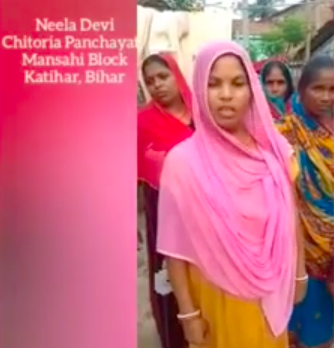Budgetary Allocation Exhausted, COVID-19 Package Not Released Yet: NREGA Tracker
Amid the raging pandemic which has had a devastating effect on livelihoods across India. accompanied by a crumbling economy, the government may have finally woken up to the importance of the Mahatma Gandhi National Rural Employment Guarantee Act (MGNREGA). In light of the current crisis, Rs 40,000 crore were allocated by the GoI, in addition to the original allocation of Rs 60,000 crore made in the Union Budget in February 2020. However, even before the half-way mark in this financial year, around Rs 64,000 crore have already been spent.
The People’s Action for Employment Guarantee (PAEG), which has been closely monitoring and advocating the need for the implementation of MGNREGA, in its latest tracker reports has however, revealed that there is still a deficit of more than Rs 481 crore. The group has stated that unless the additional promised amount of Rs 40,000 crore is released immediately, delays in wage payments that have already begun will compound the woes of the marginalised.
States unable to provide work as livelihoods suffer irreversible damage
Data compiled by the group suggests that most states are unable to provide a 100-day guarantee that the scheme mandates. Moreover, another larger question that remains is concerning households that need work and have exhausted the 100 days period. The tracker highlights that across India, 6.8 lakh households have already completed 100 days of work, but this is only 1.2% of those employed under MGNREGA. In addition to this, 51 lakh households have already completed 70 days of work. Only some states are able to provide a full 100 days to a larger share of households such as Andhra Pradesh (2.6 lakh), Chhattisgarh (84,000), West Bengal (82,000) and Odisha (52,000). However, an enormous number of the population-- 1.55 crore persons who have demanded work have not got work under the scheme. This unmet demand is the highest in Uttar Pradesh (27%), followed by Madhya Pradesh(22%) and Bihar (20%).
Speaking at the online press conference while releasing the report, Anandita, a member of PAEG, said, “These are conservative figures because MIS (MGNREGA Management Information System) only shows the number of people and households who have demanded work and got a receipt. While the MIS shows the number of days of employment generated, it does not show the total number of days of work demanded. True unmet demand is likely to be much higher.”
Also read: MGNREGA Activist to Voice Workers’ Issues in Upcoming Bihar Assembly Election
“India was going through a massive agrarian distress with stagnant rural incomes and high levels of unemployment well before the onset of the pandemic. This is a first in four decades pointing to substantially low income levels. Similarly, unemployment levels have also been the highest in four decades. It was in this context that numerous academics and activists had demanded a minimal allocation of Rs 1 lakh crore for NREGA well before the onset of the pandemic. The current crisis induced by the lockdown has amplified the misery and distress of the working class. There is, therefore, an urgent need to further underscore the importance of NREGA as a lifeline for millions of poor in the country as one way to resurrect their lives,” she added.
Economist Jayati Ghosh said, “The crisis in the Indian economy and the GDP decline is an underestimation of the problem as it does not count the informal sector. When a proper assessment is made there will be a much bigger decline as the GDP is primarily an aggregate number, the livelihoods of the workers have been the worst affected. Workers are working for 1/3rd of what they got before. Public spending is far too little, it has to be made much higher to keep the economy afloat.”
Rejected transactions--lost hope
Currently, the Government of India has a negative balance of Rs 481 crore (total pending liabilities) with respect to the scheme, according to PAEG.
The system of releases from Centre to states as per Labour Budgets also means that some states have much higher pending liabilities. Data by the group suggests that Rs 1,200 crore wage payments continue to be rejected. Payments get rejected due to technical reasons such as incorrect account numbers, incorrect mapping of Aadhaar with bank accounts etc. Across India, around 1 in every 23 transactions get rejected, which is worsening the crisis, the report said. In addition to this, workers are usually in the dark about how to rectify them. Unless rejected payments get rectified the workers don’t have access to their own wages. As of July 2020, over the last five years, a whopping Rs 4,800 crore of wage payments have been rejected. (more than five crore transactions). Wages for 6.43 crore days of work remain rejected and unresolved.

An informal worker under the scheme, Neela Devi from Katihar in Bihar, said during the press conference, “We are not getting the money for the work we have done. With supply chains disrupted, the work we get is erratic. We are forced to return to our houses on an empty stomach since there is no other option.” Several hundreds of workers continue to suffer in silence like her.
This is not all, over the last six years, MGNREGA has been plagued with several issues. The programme has been routinely under-funded, resulting in it becoming a de facto supply-driven programme, with massive delays in wage payments for even those who managed to secure work.
Anuradha Talwar of the NREGA Sangharsh Morcha said, “There are two things that the BJP government is failing to understand – one is the fact that it is the right of the people to get employed and paid under NREGA. Even if one were to keep this aside, it is imperative for the demand stimulus for the government to fund the scheme. We are demanding for 200 days of work, it may seem unachievable but it is possible on part of the government. They have a charter which states that under disastrous circumstances days of work can be extended to 150. Even if this is not possible they have to issue job cards to cover more people.”
Also read: Implement MGNREGA to Deal with Unemployment Crisis, Eminent Citizens Urge Rural Development Ministry
Get the latest reports & analysis with people's perspective on Protests, movements & deep analytical videos, discussions of the current affairs in your Telegram app. Subscribe to NewsClick's Telegram channel & get Real-Time updates on stories, as they get published on our website.
























